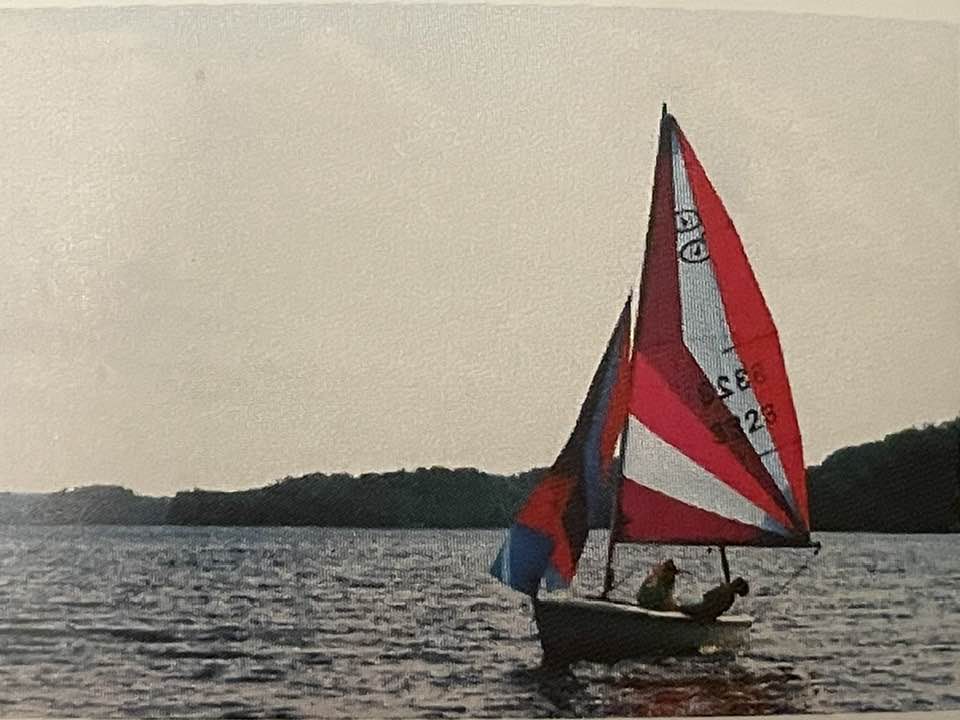JUNE 8, 2025 – (Cont.) A year after the Love Boat voyage, Beth and I were married—in the exact spot where we’d met . . . overlooking the great inland sea that is Grindstone Lake. In October 1989, our second son arrived, and soon thereafter, we bought the very cabin where I’d drifted toward after having capsized seven years before.[1] The place had come with a rollaway dock and a flimsy old hand-cranked boat lift. Now with a lake cabin of our own, it was time to buy a proper sailboat; not a teenager’s Sunfish but a proper sloop with a proper cuddy, and bench seats with ample capacity for a skipper and crew of three. After a modest search I found the perfect boat—a Catalina 14.2 Capri. The ”14.2” stood for its LOA or “length overall” expressed in feet. For $2,100 I bought it brand new from the Johnson Boat Works in White Bear Lake, Minnesota, and borrowed a trailer to haul it to its new home. Manufactured in California, its jib and mainsail were brightly colored—pink, blue, and purple. For enhanced visual navigation, the jib sail had a sizable clear plastic window to allow the crew to see ahead of the bow. On the tack of the mainsail was the manufacturer’s informational patch. In bright red lettering the words “Computerized Design” suggested the application of advanced technological innovation, which over time grew less impressive to the point of quaintness.
In fact, the Capri was more sophisticated than my earlier sailboats. As with aviation, however, sailing works off the same basic operating principles no matter what the size or sophistication of the air- or watercraft. It didn’t take me long to master the more complex rigging and to become a proficient helmsman of the new sailboat. She was a beauty to behold, and though I never got to see it from a distance, since I was always aboard, I did get to see photos of it and videos after GoPro cameras hit the market. On several occasions too, I’d be out on the lake aboard some other vessel when fully rigged, the Capri was left behind at its mooring.
I tried to name it—Gliss en d’eau (“Gliss in the water”)—a play on the musical term Glissando, which was the name of a larger sailing vessel back at Interlochen. Unfortunately, I never got around to finding the correct style of letters to apply to the transom, so the name never stuck, as it were.
On the Capri’s very first weekend at Grindstone, it nearly met its demise. Its miraculous salvation, however, was delivered by the same immense and fickle wind that had threatened to destroy it. Both ends of the story played out not more than 40 feet from where Beth and I were sitting when the early June storm unleashed its wrath. (Cont.)
Subscribe to this blog and receive notifications of new posts by email.
© 2025 by Eric Nilsson
[1] The small seasonal dwelling had changed hands twice after Beth’s parents and her oldest brother had owned it. The brother purchased a lot down the shore and built a new place; her parents and other brother acquired a lot farther yet down the shore and built a cabin as well. The original place that Beth and I purchased was small but suited our wants and needs at the time. With a screen porch that stretched across the front, the simple little pre-fab cabin with a generous side deck had been sited just 30 feet from the water’s edge—a few years before the current minimum setback of 75 feet had become law. Now occupied by a tall screen of vegetation, back in our day the sandy shore was entirely clear and a perfect place for young kids. The water was shallow, reaching no more than 18 inches extending many feet out—a fact that would bring negative consequences in a later chapter of this story.
